Finally did some basic repair work on a 14' Chestnut Playmate / Peterborough Mermaid picked up last fall. Luckily, the woodwork was in outstanding shape except for some minor issues that could be handled with some exterior, water resistant wood filler and a coat of varnish. Had some of this stuff handy for some home repairs so ended up using it...
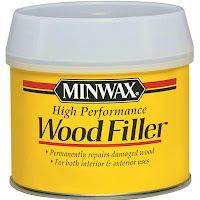
The original canvas was thoroughly cracked and will need to be replaced soon, but in order to get the canoe in the water this summer, I opted for the relative shortcut route of trying to salvage the canvas.
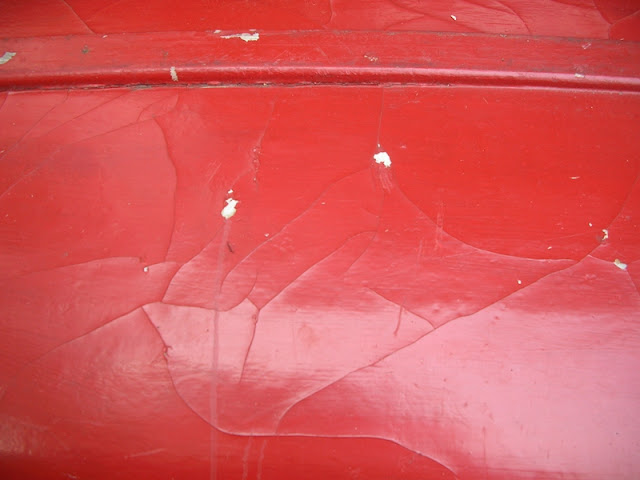
After carefully sanding and scraping away at loose paint flakes, the hull was left with plenty of superficial scars. Could've simply repainted but the surface would have been quite uneven. Ended up getting a tip to use the same exterior wood filler to on a the surface to fill the larger cracks and missing paint flakes. Here's a shot of all the spot repairs before sanding off the excess dried putty.
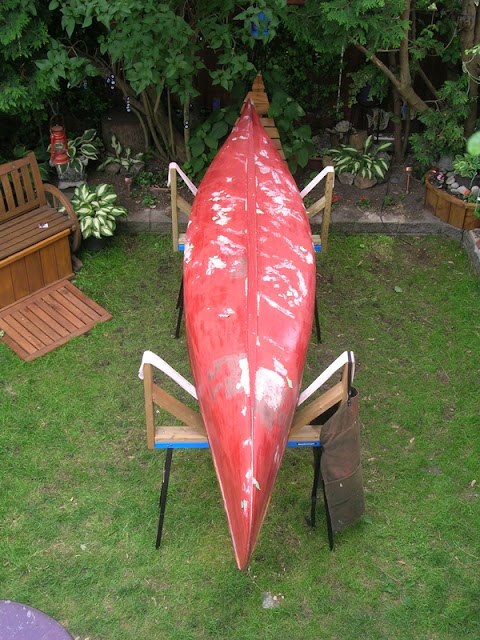
Apparently some folks report epoxy based fillers used on a whole canoe canvas is less flexible and more prone to crack in the long run, but figured this patchy job should work until the canvas is replaced in a few years anyway. At any rate, I was happy with the results. When sanded smooth, the wood filler helped fill the uneveness easily.
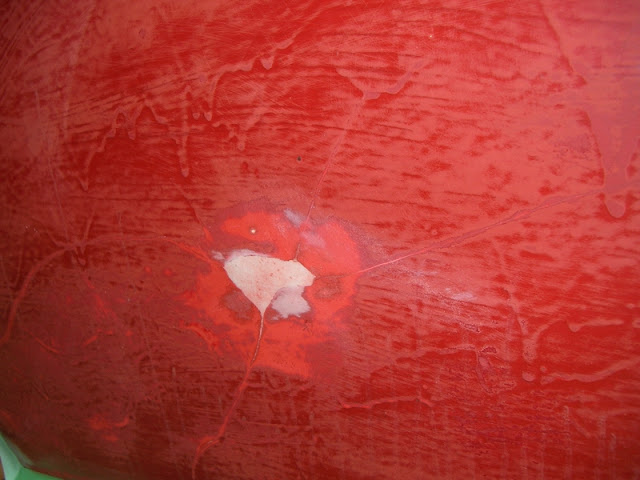
The previous owner had replaced the original hand woven cane seats with some a prewoven mat. They simply jammed the ends into the holes. They were obviously "sitters" because these dried bits of cane would certainly scratch the back of the legs for anyone who kneels.
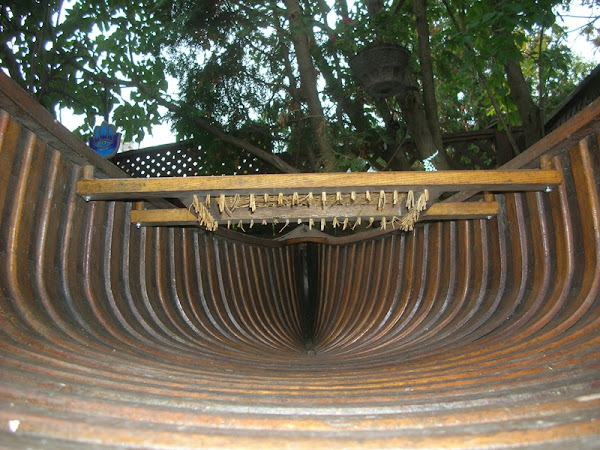
Ended up using some garden snips to cut the ends as flush as possible. The cane is still strongly held in place and now I'd be able to kneel without irritating the back of the legs.
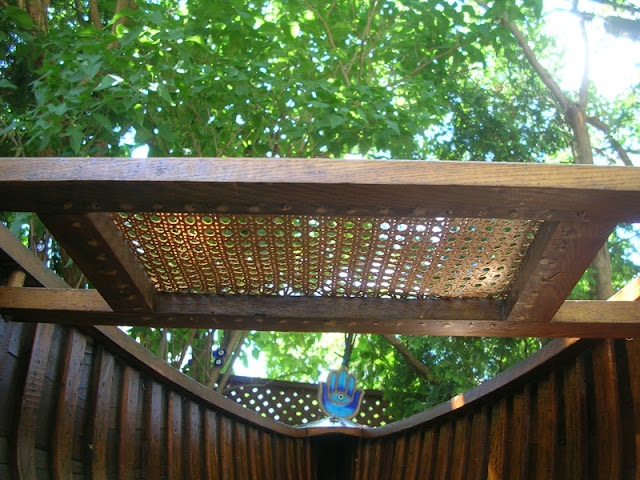
Not sure if it was necessary, but ended up using a layer of primer in addition to the paint. Used these oil rust paints as a cheapo alternative to marine enamel...
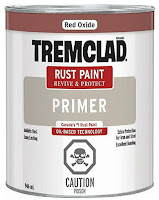
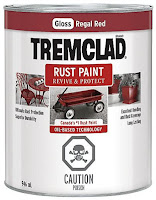
The last paint job was also pretty sloppy. The brass stem bands were painted over. This meant the tiny screw heads were filled and would take forever to pick clean to properly remove. So in the end, I just polished the stem bands best I could and left them in place. Here it is ready to go...
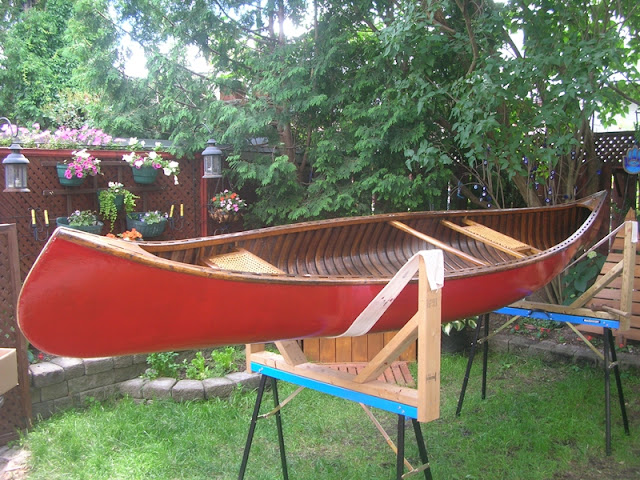
Also had been slowly working on another paddle blank since last year. This one is made from sassafras. Spent part of the winter burning an abstract design on the blade and grip. Thought it would be nice to use this new paddle for the canoe's maiden water dip. Animal tail haters can feel free to look away.
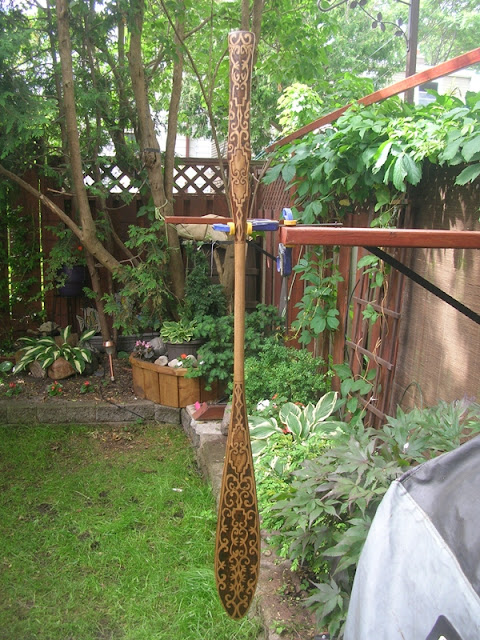
To check out if everything sealed up properly, took the boat down to Lake Ontario (10 min drive) and planned to paddle around the protected waters of the Leslie Spit / Tommy Thompson Park.
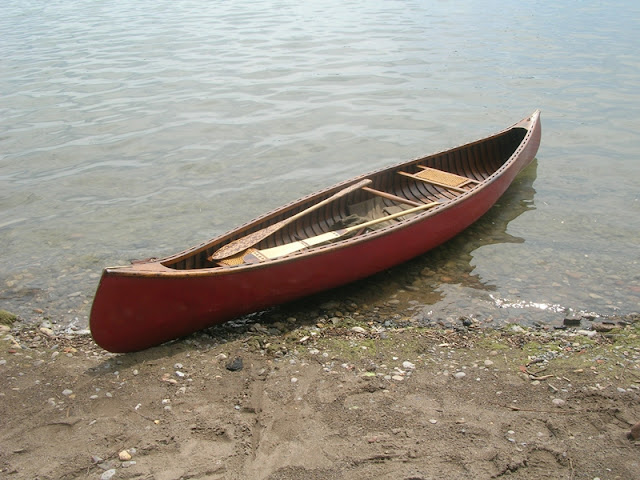
After confirming that no water was gushing into the boat, I proceeded to do a little tour of the bay. The Leslie Spit is actually an urban dump for concrete construction waste and dredged sediment but parts of it have become a naturalized bird sanctuary. There is also a healthy popluation of urban coyotes taking up residence here too. Here's a shot of the shoreline...
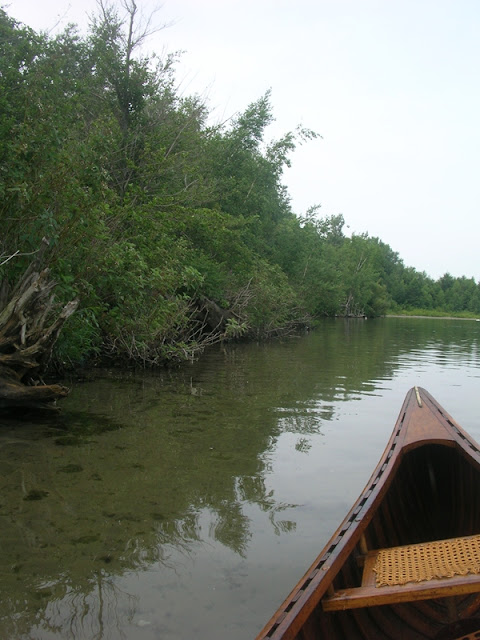
Loads of ducks and waterfowl abound, but I was drawn to follow a pair of mute swans in the distance...
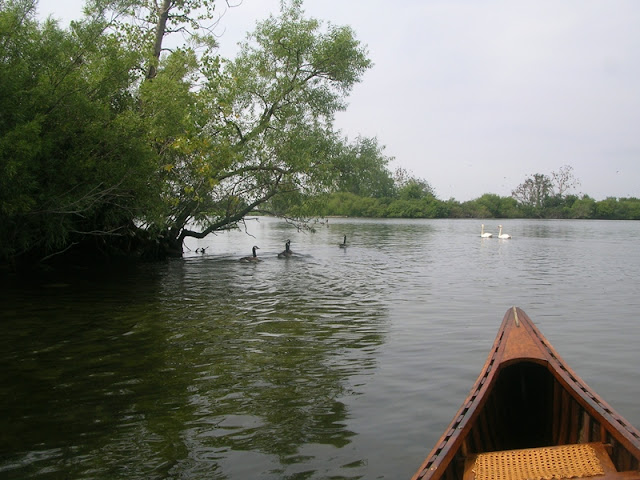
Around one bend, I started to smell a strong fishy odour only to see this beast dead on shore. For size reference, there is a washed up can at the upper left. Some type of carp I suppose?
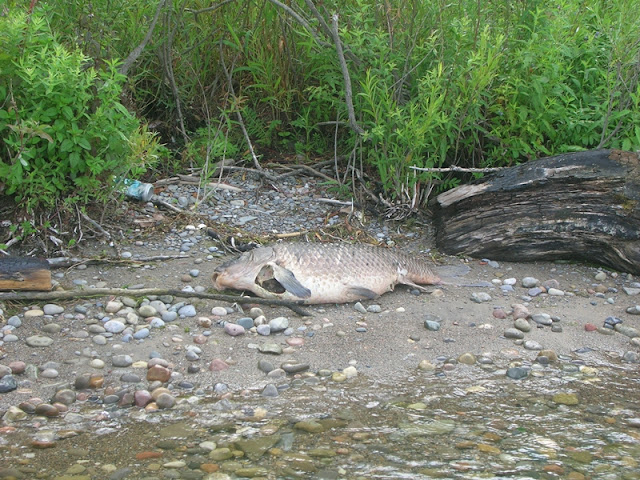
Anyway, more paddling and one quickly realizes that Tommy Thompson Park has become a huge nesting ground for Cormorants. Their guttural croaks silhouetted outlines make the whole area look pretty eerie.
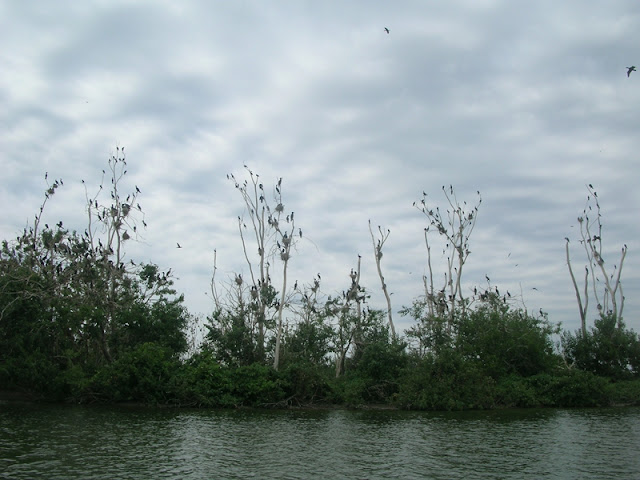
Always reminding you that you are in an urban centre, started to hear some aggressive motor roaring. It was a Police Boat zooming off to an emergency call. The wake was enough to tip over two urbanites on standup paddle boards as well as a recreational kayaker who were behind me.
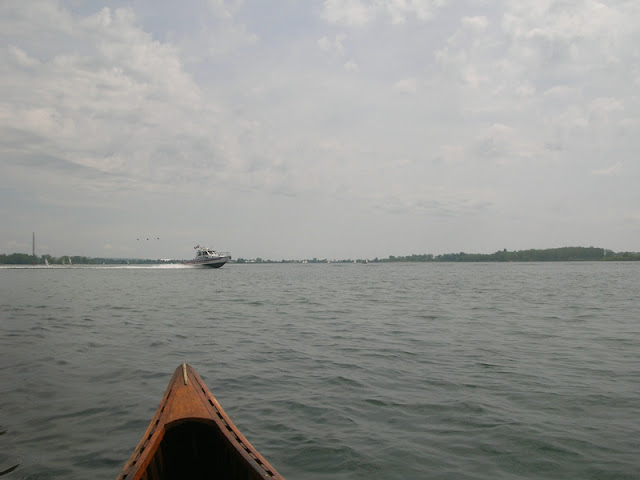
Eventually turned around and took a last look at the city skyline before heading back in...
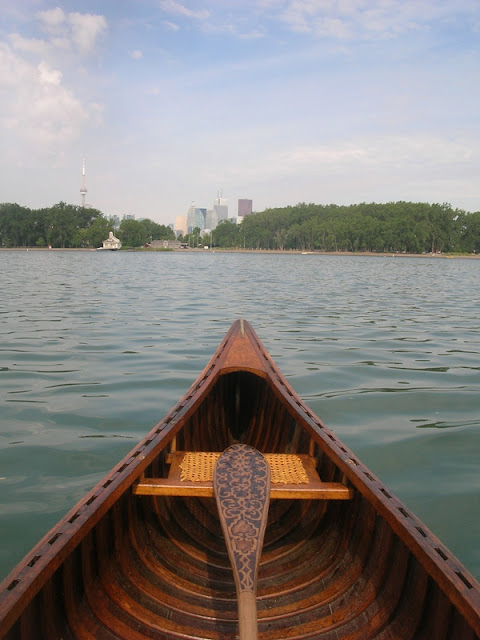
There is a little bit of water seepage from the stern stem which can be easily dealt with some more sealant. Looks like I'll need to remove the stem band after all to seal properly. Anyway, didn't take that much to give this little canoe a few more seasons of life before a full on restoration in a few years.

The original canvas was thoroughly cracked and will need to be replaced soon, but in order to get the canoe in the water this summer, I opted for the relative shortcut route of trying to salvage the canvas.

After carefully sanding and scraping away at loose paint flakes, the hull was left with plenty of superficial scars. Could've simply repainted but the surface would have been quite uneven. Ended up getting a tip to use the same exterior wood filler to on a the surface to fill the larger cracks and missing paint flakes. Here's a shot of all the spot repairs before sanding off the excess dried putty.

Apparently some folks report epoxy based fillers used on a whole canoe canvas is less flexible and more prone to crack in the long run, but figured this patchy job should work until the canvas is replaced in a few years anyway. At any rate, I was happy with the results. When sanded smooth, the wood filler helped fill the uneveness easily.

The previous owner had replaced the original hand woven cane seats with some a prewoven mat. They simply jammed the ends into the holes. They were obviously "sitters" because these dried bits of cane would certainly scratch the back of the legs for anyone who kneels.

Ended up using some garden snips to cut the ends as flush as possible. The cane is still strongly held in place and now I'd be able to kneel without irritating the back of the legs.

Not sure if it was necessary, but ended up using a layer of primer in addition to the paint. Used these oil rust paints as a cheapo alternative to marine enamel...
The last paint job was also pretty sloppy. The brass stem bands were painted over. This meant the tiny screw heads were filled and would take forever to pick clean to properly remove. So in the end, I just polished the stem bands best I could and left them in place. Here it is ready to go...

Also had been slowly working on another paddle blank since last year. This one is made from sassafras. Spent part of the winter burning an abstract design on the blade and grip. Thought it would be nice to use this new paddle for the canoe's maiden water dip. Animal tail haters can feel free to look away.

To check out if everything sealed up properly, took the boat down to Lake Ontario (10 min drive) and planned to paddle around the protected waters of the Leslie Spit / Tommy Thompson Park.

After confirming that no water was gushing into the boat, I proceeded to do a little tour of the bay. The Leslie Spit is actually an urban dump for concrete construction waste and dredged sediment but parts of it have become a naturalized bird sanctuary. There is also a healthy popluation of urban coyotes taking up residence here too. Here's a shot of the shoreline...

Loads of ducks and waterfowl abound, but I was drawn to follow a pair of mute swans in the distance...

Around one bend, I started to smell a strong fishy odour only to see this beast dead on shore. For size reference, there is a washed up can at the upper left. Some type of carp I suppose?

Anyway, more paddling and one quickly realizes that Tommy Thompson Park has become a huge nesting ground for Cormorants. Their guttural croaks silhouetted outlines make the whole area look pretty eerie.

Always reminding you that you are in an urban centre, started to hear some aggressive motor roaring. It was a Police Boat zooming off to an emergency call. The wake was enough to tip over two urbanites on standup paddle boards as well as a recreational kayaker who were behind me.

Eventually turned around and took a last look at the city skyline before heading back in...

There is a little bit of water seepage from the stern stem which can be easily dealt with some more sealant. Looks like I'll need to remove the stem band after all to seal properly. Anyway, didn't take that much to give this little canoe a few more seasons of life before a full on restoration in a few years.
